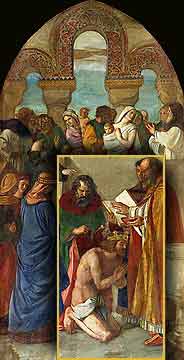The Baptism of King Ethelbert
© 2007
Armchair Travel Co. Ltd. - This page may be used for non-commercial purposes
ONLY!
![]()

[ Play
Narrated and Animated Movie ! ] In the foreground, the kneeling king is Ethelbert, King of Kent at the end of the sixth century. He is near-naked, because he has come to be baptised a Christian, at the hands of the man on the right, who is no less a figure than Saint Augustine, sent by the Pope to convert the king and to be a missionary in the pagan Saxon lands of Britain.
To the left of the kneeling king is his wife, Queen Bertha, who was daughter of the king of the Franks, and whose Christianity had led to her husband's conversion. Ethelbert, after his baptism, became a vigorous worker for his new faith, influencing thousands of his subjects to follow his example.
The scene is set here as an example of the Spirit of Religion, and is paired with a fresco at the opposite end of the Chamber by J.C. Horsley, which has that title.
In comparison to those in the Robing Room or the Royal Gallery the mural paintings in the Lord's Chamber are, if anything, recessive rather than dominant. It has been hard for them to compete with the craftsmanship of Pugin's interior details, in particualr the maginificance of the throne.
At the time of the commission Victorian historians were looking back to the Middle Ages and their teaching proclaimed the virtues of the 'High Middle Ages'. The commissioning body chose subject matter which therefore extolled such virtues which the Victorian Age sought in its society: justice, religion and chivalry. Three frescoes directly represent these, whilst in the other three these virtues are expressed in historical narrative. In one, Prince Henry encounters the meaning of justice; in another, King Ethelbert is baptised into the Church in recognition of religion; and Edward III expresses the spirit of chivalry by founding the Order of the Garter, and making his son a knight.
[ Virtual
Tour ] [ Main Topics
Index ]



Additional Information on
The Baptism of King Ethelbert
Explore-Parliament.net: Advanced Category Search
Keyword Categories:
_Setting_England
_Object_Painting
_Object_Artwork
_Event_Historical
_Artist_Cope
_King
_Royal_Family
_Man
_Person
_Queen
_Woman
_Consort
_Ethelbert